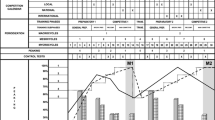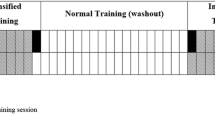Abstract.
Little is understood about the immune responses to heavy resistance exercise. The purpose of this investigation was to determine the influence of physical strength and the ability to do more total work on lymphocyte proliferation after an acute bout of heavy resistance exercise. A group of 50 healthy but non-strength trained women were recruited for the study and tested for their one repetition maximum (i.e. 1 RM or maximal mass lifted once). From the normal distribution of strength the top and bottom 8 women [mean age 22.5 (SD 3.1) years] were asked to volunteer to define our two groups (i.e. high strength and low strength). The two groups were significantly different (P<0.05) in 1 RM squat strength [low strength 39.9 (SD 4.6) kg, 0.65 (SD 0.08) kg·kg body mass–1 and high strength 72.2 (SD 10.7) kg, 1.1 (SD 0.12) kg·kg body mass–1] but were not significantly different in body mass, age, activity levels, and menstrual status (all in same phase). Each performed a resistance exercise protocol consisting of six sets of 10 RM squats with 2 min rest between the sets. The 10 RM loads and total work were significantly greater in the high strength group than in the low strength group. Blood samples were obtained pre-exercise and immediately post-exercise for test for lactate (significant increase with exercise) and cortisol (no changes) concentrations with no differences noted between groups. Immunological assays on the blood samples determined the incorporation of tritiated thymidine by lymphocytes in responses to concanavalin A (ConA), phytohemagglutinin (PHA), and pokeweed mitogen (PWM). Following the squat exercise, there was a significant decrease in lymphocyte responsiveness to PWM in the high strength but not in the low strength group for both total proliferation and proliferation adjusted per B or T cell. On the other hand, lymphocytes from the low strength group proliferated to a significantly greater extent (adjusted per T cell) in response to ConA and PHA. These data indicate that the heavy resistance exercise protocol reduced the lymphocyte proliferative responses only in the stronger group of subjects. This effect may have been due to the high absolute total work and the greater exercise stress created by the resistance exercise protocol in the high strength group. Therefore, individuals performing at the same relative exercise intensity (i.e. 10 RM) in a resistance exercise protocol may have different immune responses stemming from differences in absolute total work performance.
Similar content being viewed by others
Author information
Authors and Affiliations
Additional information
Electronic Publication
Rights and permissions
About this article
Cite this article
Dohi, K., Mastro, A.M., Miles, M.P. et al. Lymphocyte proliferation in response to acute heavy resistance exercise in women: influence of muscle strength and total work. Eur J Appl Physiol 85, 367–373 (2001). https://doi.org/10.1007/s004210100388
Accepted:
Issue Date:
DOI: https://doi.org/10.1007/s004210100388




